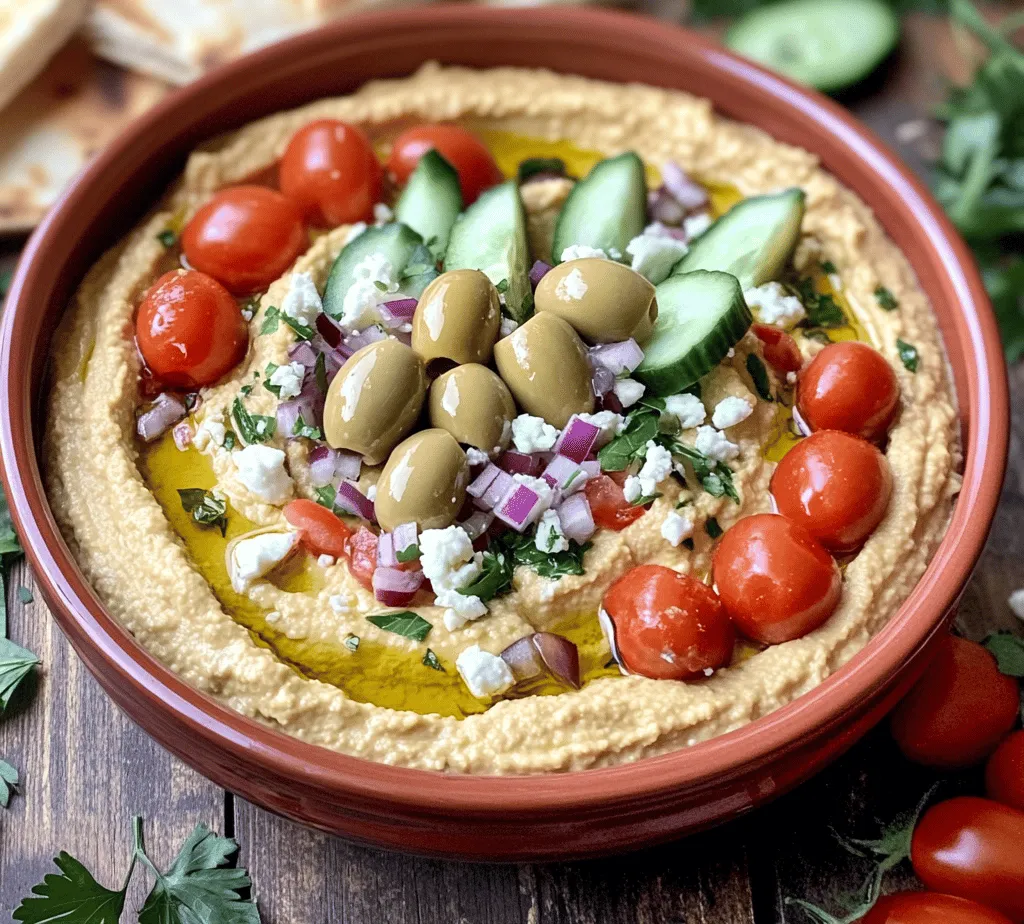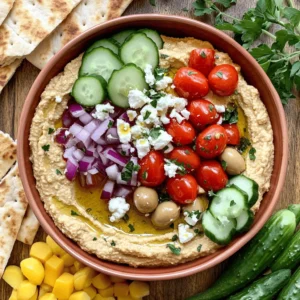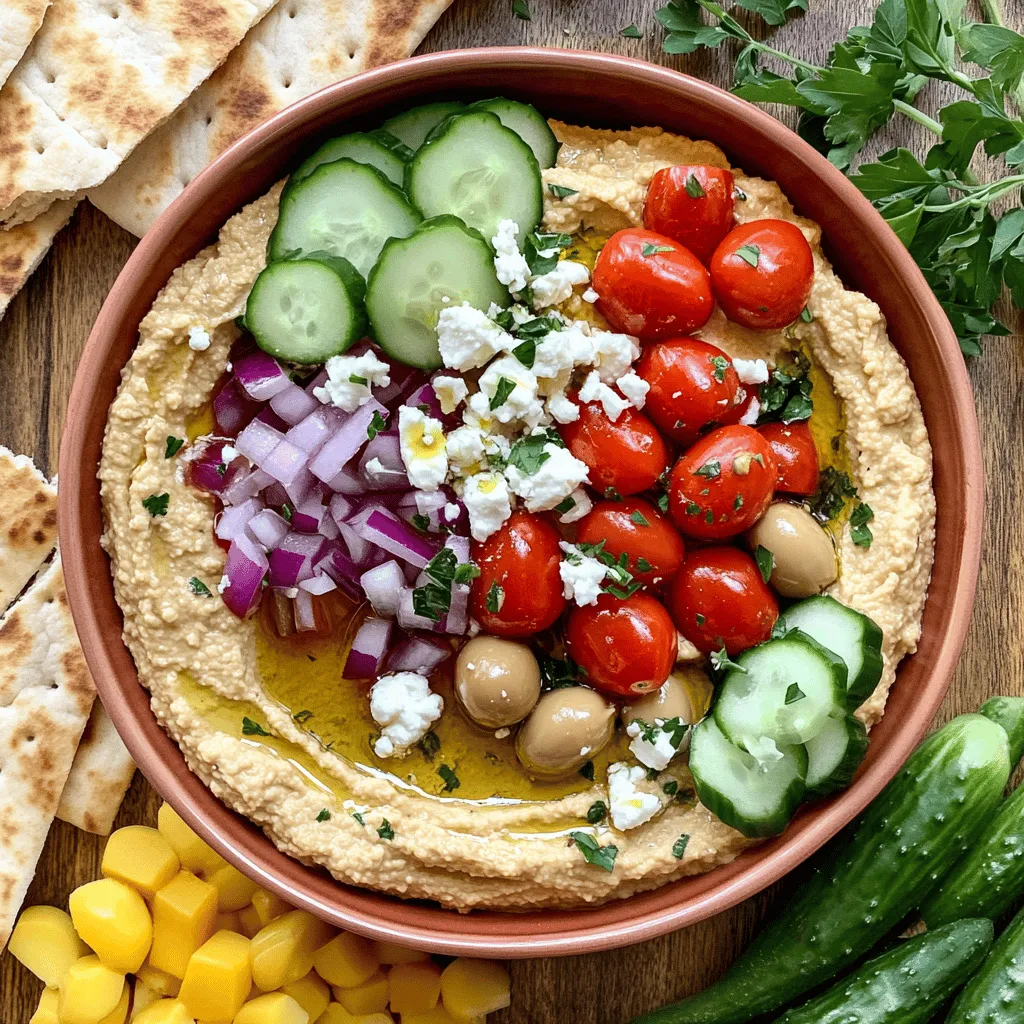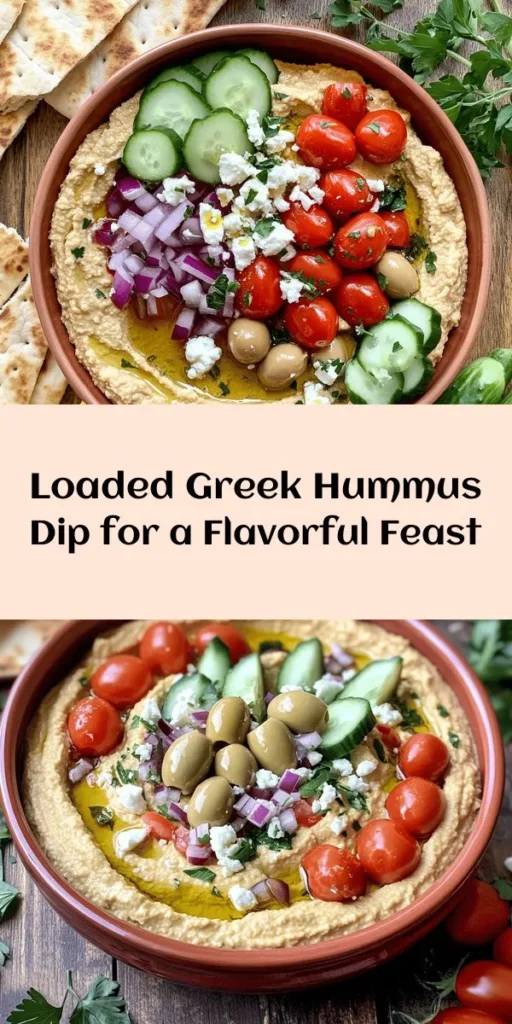Introduction
Greek cuisine is celebrated worldwide for its vibrant flavors, fresh ingredients, and health benefits. Characterized by the use of wholesome vegetables, lean meats, and healthy fats, Greek food is not only delicious but also provides a balanced approach to nutrition. At the heart of this culinary tradition lies hummus, a creamy dip made primarily from chickpeas, which has become a staple in Mediterranean diets. Hummus is packed with protein, fiber, and essential vitamins, making it a popular choice for health-conscious individuals.
Among the many variations of hummus, the Greek Style Loaded Hummus stands out as a delightful twist on the classic recipe. It combines the traditional flavors of hummus with a medley of fresh toppings that reflect the essence of Greek cuisine. This dish is not just a dip; it’s an experience—perfect for a casual appetizer, a midday snack, or as part of a more elaborate main meal. The loaded hummus can easily adapt to any occasion, whether you’re hosting a gathering or simply enjoying a quiet night in.
Understanding the Ingredients
To create a Greek Style Loaded Hummus that is both flavorful and nutritious, it’s essential to understand the ingredients that make up this dish. Each component plays a crucial role in delivering taste and health benefits.
Chickpeas
Chickpeas, also known as garbanzo beans, are the star ingredient in hummus. These legumes are not only versatile but are also packed with nutrition. Rich in protein, fiber, and essential vitamins and minerals, chickpeas can help improve digestion, stabilize blood sugar levels, and promote heart health. Their creamy texture when blended makes them the perfect base for hummus. When choosing chickpeas, you can use canned ones for convenience or dried chickpeas that require soaking and cooking for a more authentic taste.
Tahini
Another key ingredient in hummus is tahini, a paste made from ground sesame seeds. Tahini adds a rich, nutty flavor that enhances the overall taste profile of the dish. In addition to its delicious taste, tahini is a nutritional powerhouse, providing healthy fats, protein, and important vitamins such as B vitamins and vitamin E. It also contains minerals like calcium, magnesium, and iron, making it a fantastic addition to your diet.
Olive Oil
Olive oil is a staple in Mediterranean cooking and has been celebrated for its numerous health benefits. Rich in monounsaturated fats, it is known to support heart health and reduce inflammation. When drizzled over hummus, olive oil adds a silky texture and enhances the dish’s flavor. Opt for high-quality extra virgin olive oil, which is less processed and retains more of its natural antioxidants and nutrients.
Fresh Lemon Juice
Fresh lemon juice is essential for balancing the flavors in hummus. It adds a bright, zesty note that cuts through the richness of tahini and olive oil. Additionally, lemon juice is packed with vitamin C, which boosts the immune system and promotes healthy skin. The acidity from the lemon juice also helps to elevate the overall taste of the hummus, making it more refreshing and enjoyable.
Garlic and Cumin
Garlic is another integral ingredient that brings depth and an aromatic quality to hummus. Its robust flavor complements the other ingredients while also providing health benefits, such as improved immune function and anti-inflammatory properties. Cumin, a spice often used in Mediterranean and Middle Eastern cuisines, adds an earthy warmth that enhances the flavor of the hummus. Both garlic and cumin can be adjusted according to personal preference, allowing you to tailor the taste to your liking.
Toppings: Fresh Vegetables, Feta Cheese, and Olives
The beauty of Greek Style Loaded Hummus lies in its toppings. Fresh vegetables such as cucumbers, bell peppers, and cherry tomatoes not only add vibrant color but also provide crunch and freshness. Feta cheese, a classic Greek dairy product, brings a salty creaminess that pairs beautifully with the smooth hummus. Lastly, olives, whether Kalamata or green, contribute a briny depth that complements the other flavors.
Each topping not only enhances the flavor and texture of the dish but also contributes to its nutritional value. The vegetables are rich in vitamins and antioxidants, while feta cheese offers calcium and protein. Olives are a source of healthy fats and contain anti-inflammatory properties, making this dish as wholesome as it is delicious.
Preparation Steps for Greek Style Loaded Hummus
Creating Greek Style Loaded Hummus is a straightforward process that involves blending the base ingredients and preparing the toppings. Here’s a step-by-step breakdown to guide you through making this delectable dish.
Step 1: Prepare the Chickpeas
If using dried chickpeas, start by soaking them overnight in plenty of water. This helps to soften them and reduces cooking time. The next day, drain and rinse the chickpeas before boiling them in fresh water for about 1 to 1.5 hours, or until they are tender. If using canned chickpeas, simply drain and rinse them under cold water to remove excess sodium.
Step 2: Blend the Base Ingredients
In a food processor, combine the prepared chickpeas with tahini, fresh lemon juice, minced garlic, ground cumin, and a pinch of salt. Begin processing the mixture, adding a few tablespoons of water or olive oil as needed to achieve a smooth consistency. For a creamier hummus, blend for longer, scraping down the sides of the bowl to ensure all ingredients are well incorporated. Adjust the seasoning by tasting and adding more lemon juice, salt, or garlic as desired.
Step 3: Achieve the Perfect Consistency
The key to perfect hummus lies in its consistency. It should be smooth and creamy but not too runny. If your hummus is too thick, gradually add more water or olive oil, blending until you reach your desired texture. If it’s too thin, you can add a few more chickpeas or a bit more tahini to thicken it up.
Step 4: Prepare the Toppings
While the hummus is blending, prepare your toppings. Dice fresh vegetables like cucumbers, bell peppers, and cherry tomatoes into bite-sized pieces. For the feta cheese, crumble it into small chunks, and if you’re using olives, slice them or leave them whole based on your preference. Arrange the toppings on a plate or in a bowl so that they are ready to be added to the hummus.
Step 5: Assemble the Loaded Hummus
Once the hummus is blended to perfection, transfer it to a serving dish. Use the back of a spoon to create a small well in the center of the hummus. Drizzle a generous amount of extra virgin olive oil over the top, then artfully arrange the diced vegetables, crumbled feta cheese, and olives in the well and around the edges. This not only looks visually appealing but also makes it easy for guests to scoop up their desired toppings.
Tips for Achieving the Best Results
– Use high-quality ingredients: For the best flavor, opt for fresh, organic ingredients whenever possible.
– Experiment with flavors: Feel free to add other toppings such as roasted red peppers, sun-dried tomatoes, or even a sprinkle of za’atar for an extra layer of flavor.
– Adjust textures: If you prefer a chunkier hummus, reserve some whole chickpeas to fold into the mixture after blending.
With these steps, you’ll be well on your way to creating a delicious Greek Style Loaded Hummus that everyone will love. This dish not only highlights the flavors of Greek cuisine but also provides a nourishing and satisfying option that can be enjoyed in various settings. Whether served at a gathering or enjoyed on its own, this hummus is sure to impress.

Creative Ways to Serve Greek Style Loaded Hummus
Serving Greek Style Loaded Hummus can be as creative as it is delicious. This versatile dish can be enjoyed in numerous ways, appealing to a variety of tastes and dietary preferences. Here are some exciting serving suggestions that will elevate your hummus experience:
1. Pita Bread and Veggie Sticks: The classic pairing with hummus is pita bread, whether it’s warm, toasted, or grilled. Cut the pita into wedges for easy dipping. Alongside, offer an array of colorful veggie sticks such as carrots, cucumbers, bell peppers, and celery. This adds a refreshing crunch and enhances the nutritional profile of your snack.
2. Hummus Platter: Create a stunning hummus platter by serving it in a shallow bowl surrounded by an assortment of toppings like olives, diced cucumbers, cherry tomatoes, and crumbled feta cheese. This not only makes for a beautiful presentation but also allows guests to customize their portions.
3. Hummus Sandwiches: Spread Greek Style Loaded Hummus on whole grain or sourdough bread, and layer with fresh greens, sliced tomatoes, and grilled vegetables for a hearty sandwich. This is an excellent option for a quick lunch or a picnic snack.
4. Hummus Bowls: For a more substantial meal, serve the hummus as a base in a bowl topped with grilled chicken, falafel, or roasted vegetables. Add some quinoa or brown rice for added texture and nutrition.
5. As a Dip for Chips: Use pita chips or tortilla chips for a delightful crunchy contrast. The salty, crisp texture pairs beautifully with the creamy hummus.
6. Stuffed Peppers: Hollow out mini bell peppers and fill them with Greek Style Loaded Hummus for a fun, bite-sized appetizer. They’re colorful and easy to eat, making them perfect for parties.
Pairing Suggestions with Pita Bread and Veggie Sticks
Pita bread and vegetable sticks are perfect companions for Greek Style Loaded Hummus, but enhancing this pairing can take your dish to the next level. Here are some pairing suggestions:
– Herbed Olive Oil: Drizzle some high-quality extra virgin olive oil infused with herbs over the hummus. This adds a depth of flavor that complements the nutty chickpeas.
– Spices and Paprika: Sprinkle smoked paprika or za’atar spice blend on top for an aromatic kick. These spices not only enhance flavor but also add a splash of color.
– Pickled Vegetables: Serve a small bowl of pickled vegetables like radishes or cucumbers alongside your hummus. The tanginess of pickles balances the creaminess of the hummus beautifully.
– Cheese: Offer a side of feta or goat cheese that can be crumbled on top or served alongside. The salty, creamy texture of cheese pairs perfectly with the earthy flavors of hummus.
Ideas for Complementing the Dish with Beverages
When serving Greek Style Loaded Hummus, selecting the right beverage can elevate the dining experience. Here are some perfect pairings:
– Greek Wine: A crisp, white Greek wine such as Assyrtiko or an aromatic Retsina is an excellent choice. The acidity of these wines complements the dish’s flavors beautifully.
– Lemonade: For a refreshing non-alcoholic option, serve homemade lemonade. The tartness of lemon enhances the Mediterranean flavors, making it a perfect match.
– Sparkling Water: For a light and refreshing choice, consider sparkling water with a sprig of mint or a slice of lemon. This adds a level of sophistication without overpowering the dish.
Presentation Tips to Make the Dish Visually Appealing
Creating a visually appealing dish enhances the dining experience. Here are some presentation tips for your Greek Style Loaded Hummus:
1. Layered Toppings: Arrange toppings in a circular pattern on top of the hummus, creating an attractive and colorful display. Use contrasting colors for maximum effect.
2. Garnishes: Fresh herbs like parsley, mint, or dill can add a pop of color when sprinkled on top. A sprinkle of toasted sesame seeds can also enhance the visual appeal.
3. Serving Dish: Use a shallow, wide bowl to serve your hummus. This allows for a larger surface area for toppings and makes it easy to dip.
4. Accompaniments: Arrange pita wedges and veggie sticks artistically around the hummus. Consider using wooden boards or slate platters for a rustic look.
5. Lighting: If serving for a gathering, consider using soft lighting or candles to create a warm atmosphere that highlights the colors of the dish.
Nutritional Information
Understanding the nutritional value of Greek Style Loaded Hummus is essential for those who are health-conscious. Here’s a breakdown of what you can expect:
Overview of Nutritional Values per Serving
A standard serving of Greek Style Loaded Hummus (approximately 100g) typically contains:
– Calories: 200
– Protein: 8g
– Carbohydrates: 22g
– Dietary Fiber: 6g
– Fats: 10g
Analysis of Macronutrients: Proteins, Fats, and Carbohydrates
– Proteins: Chickpeas, the primary ingredient in hummus, provide a decent amount of protein, making it a great addition to vegetarian and vegan diets. The addition of Greek yogurt further boosts the protein content.
– Fats: The healthy fats from olive oil and tahini contribute to heart health while offering a creamy texture. These fats are essential for nutrient absorption and overall health.
– Carbohydrates: The carbohydrates in hummus primarily come from chickpeas, which are complex carbs that provide sustained energy. The high fiber content aids in digestion and helps maintain stable blood sugar levels.
Discussion on the Health Benefits of Consuming Hummus Regularly
Hummus is not only delicious but also packed with health benefits:
– Heart Health: The olive oil and chickpeas in hummus are linked to lower cholesterol levels and improved heart health.
– Weight Management: High in fiber and protein, hummus can help keep you feeling full, making it a great option for those looking to manage their weight.
– Antioxidants: Ingredients like garlic and lemon juice offer antioxidant properties that can help reduce inflammation and support overall health.
Comparison of Homemade Hummus Versus Store-Bought Options
Homemade hummus is often healthier and tastier than store-bought varieties. When making your own, you control the ingredients, which means you can avoid preservatives and excess sodium. Homemade versions allow for customization according to taste preferences and dietary needs, making it a more nutritious choice overall.
Cultural Significance of Hummus in Greek Cuisine
Hummus has a rich history within Mediterranean diets, particularly in Greek culture. Understanding its cultural significance adds depth to your appreciation of this dish.
Historical Context of Hummus in Mediterranean Diets
Hummus has been a staple in Mediterranean diets for centuries, with origins tracing back to ancient Middle Eastern cultures. Its ingredients are deeply rooted in the agricultural practices of the region, making it a symbol of local cuisine.
The Role of Hummus in Greek Gatherings and Celebrations
In Greece, hummus is often served at gatherings, celebrations, and family meals. It embodies the spirit of sharing and community, making it a popular choice for meze platters during festive occasions.
Insights into How Hummus Reflects the Mediterranean Lifestyle
The Mediterranean lifestyle is characterized by fresh, wholesome ingredients and a focus on communal dining. Hummus embodies these principles, promoting health, sustainability, and social connection.
Variations of Greek Style Loaded Hummus
While the traditional Greek Style Loaded Hummus is delightful on its own, exploring variations can lead to new and exciting flavors.
Suggestions for Alternative Toppings or Ingredients
– Roasted Red Peppers: Incorporate roasted red peppers as a topping for a sweet and smoky flavor.
– Chickpea Salad: Top with a fresh chickpea salad made of diced tomatoes, cucumbers, and red onion for added texture.
– Spicy Harissa: For those who enjoy heat, drizzle harissa sauce over the hummus for an exciting flavor twist.
Ideas for Different Flavor Profiles (e.g., Spicy, Herby)
– Spicy: Add diced jalapeños or a splash of hot sauce to the base for a spicy kick.
– Herby: Blend fresh herbs like basil, cilantro, or dill into the hummus for a refreshing herbal note.
Seasonal Variations Based on Available Fresh Ingredients
– Spring: Incorporate fresh peas or asparagus for a vibrant green hue and seasonal freshness.
– Summer: Add diced tomatoes and fresh basil for a Caprese-inspired hummus.
– Fall: Mix in roasted pumpkin or sweet potato for a rich, autumnal flavor.
Conclusion
Greek Style Loaded Hummus is a dish that beautifully encapsulates the flavors and traditions of Mediterranean cuisine. Its versatility allows for endless creativity in serving and pairing, making it suitable for any occasion. With its numerous health benefits and cultural significance, hummus is more than just a dip; it’s a celebration of community, flavor, and well-being.
By exploring the various ways to enjoy Greek Style Loaded Hummus, you can bring the rich tapestry of Mediterranean flavors into your home. Whether you stick to the classic recipe or venture into new variations, this dish promises to delight your taste buds and nourish your body. Dive into the Mediterranean lifestyle and savor every bite of this beloved dish!



